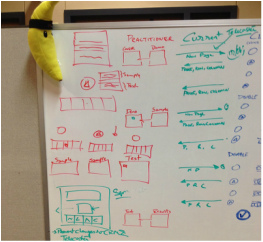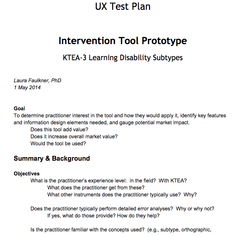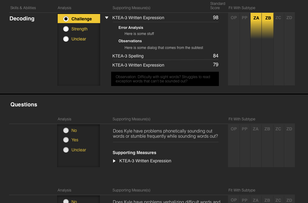Business Leadership - Intervention Tool for Learning Disabilities
This application identifies learning disabilities and delivers what can help a child's unique needs. Our team converted thousands of data points to a few simple questions, a dynamic results presentation, and immediate results.
The biggest ‘win, was not a documented deliverable it all: it was getting the business to up investment from $8k to $60k, and the creation of understanding between IT and Domain Experts that led to creation of the abstracted data model that was reusable to the extent of saving $225,000 in engineering time over the following 9 months. It was the first time that IT and Domain Content created deliverables without a ‘go between’,
The biggest ‘win, was not a documented deliverable it all: it was getting the business to up investment from $8k to $60k, and the creation of understanding between IT and Domain Experts that led to creation of the abstracted data model that was reusable to the extent of saving $225,000 in engineering time over the following 9 months. It was the first time that IT and Domain Content created deliverables without a ‘go between’,
|
The Intervention Tool for Learning Disability Subtypes provides a brief, on-screen intelligent correlation and conclusions about a particular child's performance on detailed ability tests. A practitioner need only answer a few yes/no questions; with each, the model showing the most likely subtypes changes before their eyes.
In the start of this project, I recognized that the domain scientists were building a one-off model. If it was not accepted by the market, this would matter little. If it succeeded, others like it would need to be built. Connecting the domain scientist and engineering architect, I facilitated and translated between them toward the design and build of a repeatable, reusable data model, database structure, and design language. This effort had an enduring collateral effect: development of deep-level expertise on both sides of the aisle. You will now hear engineers routinely mention learning disabilities, while domain scientists calmly talking about abstracting variables and data models. This capability for multiple reuses inspired new products and possibilities along with an existing capability to build them quickly and robustly.
|
|
|
From ideation to prototype to UX test to market release
|
In design studio, I facilitated and documented the intersection of two brilliant, but disparate minds: the domain scientist, and the engineer. The meeting of great minds resulted in a reusable data model and flexible database design.
|
We took an early prototype to user testing. Facilitating agreed goals and areas of inquiry unique to this market test product, supported buy-in and a thoughtful test plan. UX, Product Management, and Marketing worked together to gather and analyze qualitative and quantitative results. We came out with a simpler design.
|
A market test product was an ideal opportunity to let the visual designer loose from our typical design language. The team provided goals to convey this as a "smart tool" and something wholly new in the field. The futuristic, interactive design brought an intake of delighted breath. The combined result of backend sophistication and front-end beauty and function elicited from practitioners, "We love it!"
|




